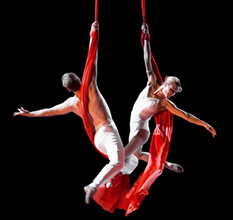Two of the three works on the Miró Quartet’s April 23 Fletcher Opera Theater program, presented on the Raleigh Chamber Music Guild’s Masters Series, represented their composers’ attempts to render musically difficult experiences in their lives. One of them, Smetana’s First Quartet (1876), entitled “From My Life” by the composer, is a veritable war-horse of the repertoire; the other, Brent Michael Davids’ “Tinnitus Quartet” is just a youngster, born in 2004. These two works surrounded in reverse order the intermission; the opener was Haydn’s Quartet in g minor, Op. 74/3 (1793), nicknamed by another “The Rider” because of the galloping rhythm in its outer movements. While it is not autobiographical, it does share with the Smetana some tunes and rhythms. It was impeccably played in a classy, understated manner. In a post-concert conversation, the violist said that they usually play the Beethoven Op. 18/6 rather than the Haydn in this set because he also dealt with a hearing malady that first manifested itself about the time of that work’s composition.
Tinnitus is a hearing problem also often called “ringing in the ear”; Davids, a Mohican Indian most of whose works are quite light-hearted, suffers from it. Different people experience it in different ways, some intermittently, others constantly; some softly, others deafeningly. Davids’ is the latter two elements of these pairs, in the form of a high-pitched A note, which he uses in the single-movement quartet, passing it around among the four players and surrounding it with other interesting and attractive melodies and sounds. The program notes indicate that he imagines crickets chirping to create a distraction, and they appear at the end of the piece. He has learned to live with the demon that he first fought to no avail. With this knowledge imparted in written and oral program notes, audience members might well have cringed in fear and trepidation of an impending unpleasant experience, but this is not at all what followed. The incessant A is not unlike, after all, the drone note of a bagpipe in its presence if not its sound, and not unlike the sometimes single-note continuo bass in some Baroque works. It is difficult to predict that the work will one day become the favorite that the Smetana is, but it is much more than a curiosity and bears repeat hearings. Solid applause – enthusiastic would hardly be the appropriate word here, even though it seemed such – signaled the audience’s approval.
Oral program notes again illuminated the listeners about the four movements of the Smetana work. The composer left notes about each, saying that the first attempted to reflect the struggles of a young artist; the second, with its polka rhythm, celebratory times in bars and dances; the third, a love-song tribute to his first wife,who died shortly before he composed the piece, after three of their four children had preceded her in death; and the fourth, a celebration of fame finally achieved. Smetana also suffered from tinnitus and eventually deafness; the high-pitched A appears towards the end of the fourth movement, sounding a note of despair amidst the joy. It would be difficult to imagine a more nuanced and more revealing interpretation and performance than violinists Daniel Ching and Sandy Yamomoto, violist John Largess, and cellist Joshua Gindele gave. Precision and soul were the order of the day, devoid of the grand and flashy gestures that some other young quartets seem to feel obliged to provide. Several audience members were overheard to say it was the best rendition they had ever heard; this writer would concur.
This marks the Miró’s third appearance in the Triangle. Their first was in 2002 when they inaugurated the matched set of instruments by Frank Ravatin, commissioned for them by then RCMG Board member Mark Furth. They held an open rehearsal prior to the recital on Sunday, with a Q&A afterwards, and an audience member queried them about this set. Largess responded saying that he and Ching were still playing theirs but that Yamomoto and Gindele were playing other modern instruments because they had found over time that the sounds of the matched set were too well matched and that the individual character of each instrument could not stand out from the others. This is the Miró’s tenth anniversary, and they have been Quartet in Residence at the University of Texas at Austin for the past four years. When asked if they found this confining and limiting of their touring options, they replied that the secure salaries from the half-time teaching loads relieved them of some pressure to secure gigs, and that UTA had also been generous in providing funds for them to commission new works, including the Davids, which they especially appreciated. Other audience members asked about the mechanics of quartet playing and how they worked things out. Ching responded that they tried to remain flexible and open to new ideas and to try things first rather than dismissing them outright. He said that he had dreamed of playing in a quartet from the time he was ten when he heard his first one. He is glad his dream has come true, and so are we; we wish the Miró at least another ten years of continued success and security and encourage them to stick with the playing style they have chosen. Recitals like this one are most rewarding; would that all were thus.











